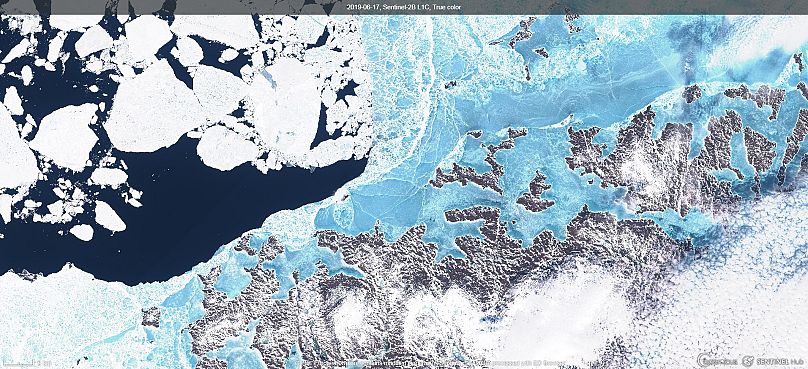The polar bear was spotted in Norilsk, hundreds of kilometres away from its natural habitat while Copernicus has released images of wildfires in the Arctic Circle.
A visibly exhausted and starving polar bear wandered into a major Russian industrial city on Tuesday, hundreds of kilometres away from its natural habitat, as widespread wildfires rage across the Arctic Circle.
Footage released on Tuesday by Oleg Krashevsky, a local wildlife expert, showed an emaciated polar bear in Norilsk, an industrial city in Siberia, located above the Arctic Circle.
It is the first polar bear seen in the city in more than 40 years, according to local environmentalists.
Polar bears have increasingly been spotted far away from their natural sea-ice habitats as climate change pushes them further afield for food.
A polar bear was flown back to the northern arctic region of Chukotka in April by Russian authorities after it was found in a village around 700km away. Two months earlier, a Russian archipelago asked for help to tackle "a mass invasion of polar bears into inhabited areas."
Using satellite imagery we can easily observe how the polar bears' natural habitat -the sea ice of the Arctic Ocean- is dispersed into small ice floes.
"Of course when the sea ice breaks up, the polar bears will seek stable ice on which they can hunt. However, if there are no seals or other food sources, then forced to keep searching" ESA Earth programme's head Mark Drinkwater told euronews.
Climate science expert Zackary Labe helped us understand the picture "The blue areas on the Sentinel-2 satellite images are showing areas of melt ponds on-top of the sea ice. Melt ponds form during the summer months as snow/ice begins to melt on the top layer of the sea ice. In the case of this satellite image, it looks likely that the sea ice is beginning to substantially melt.
Temperatures have been well above average in parts of northern Siberia this month, which has contributed to a rapid melt of snow cover and sea ice along the Siberian side of the Arctic Ocean. This is especially noticeable in the Laptev Sea" he tells euronews.
'Widespread boreal wildfire activity'
This comes as the Arctic Circle is currently hit by several wildfires. Data and images captured by the Sentinel 2 satellite of Copernicus, the European Union’s Earth observation programme, show the extent of the damage.
The World Meteorological Organization, a United Nations body, forecast at the end of May that the Arctic regions would experience above normal surface air temperatures between June and August.
"The forecast summer conditions follow winter months in which the average surface air temperature was above normal for most of the Arctic domain. Eastern Siberia experienced its second warmest November-December-January on record," it also flagged in a statement.
'High ice loss'
Greenland and Finland have also particularly been impacted.
Approximately 712,000 km2 of Greenland’s surface melted on June 12th, more than 470,000 km2 more than the same date in 2018. A picture captured earlier this month showing the ice sheet hidden beneath a shallow lake of water went viral.
Another "high ice loss day" was recorded on Sunday.
Experts monitoring the ice sheet in Greenland believe 2019 could rival 2012 when the Danish island experienced the most melting on record.
Meanwhile, there "are no known cases in Finland's climate history when it has been hotter than now so early in the summer," Mika Rantanen, a meteorologist at the University of Helsinki tweeted in early June.
The heatwave saw over 30°C recorded inside the Arctic circle (Russia) and 31°C at the coast of the White Sea, Rantanen also said.












